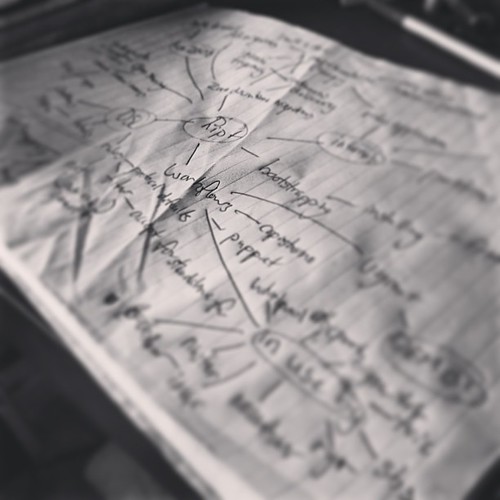Whenever I talk at conferences, I am routinely asked how I go about preparing and making my presentations.
There are no hard and fast rules, but these are some things I have learnt:
Start analog
The most limiting thing you can do when you start putting together a presentation is to reach for slideware. I use a paper notebook to brainstorm my ideas with multicoloured pens, then scan it so I can refer back to it quickly when putting the slides together.

Don’t create slides linearly
I focus on an idea in the brainstorm that surprised me the most when I wrote it down, and use it as a jump-off point for creating slides. I’ve found exploring that initial idea helps set the tone for the rest of the presentation.
Weave a story
Kathy Sierra used to bang on about this heaps. We’re wired as a species to find stories interesting, so use this to your advantage.
But don’t concoct a story just for the talk - try to relate the content back to your own experiences. Nobody wants to hear about Alice and Bob, they want to hear you and your co-workers rise above adversity and the setbacks you had along the way.
Chris Fegan’s NBNCo talk at Puppet Camp Sydney 2013 was a good example of how to weave technical detail into an organisational growth story.
Use slides appropriately
They are a visual aid, and a visual aid alone. People’s attention should be on you - you are the speaker after all! Use lots of supporting visuals, and minimal text. No bullet point lists! Put each point on a separate slide.
I use Flickr’s Creative Commons search to find relevant images, and favourite them when I want to use them again across multiple presentations. Sometimes they even provide a visual trigger that moves the presentation in a direction I wasn’t expecting.
If I post the slides after the presentation, it’s always nice to comment on the picture on Flickr to let the photographer know I appreciate their contributions to Open Culture.
Don’t rely on the slides
Ideally if your laptop died 5 minutes before the talk, you should know your material well enough that you could deliver it by voice alone.
Be thorough
Shortcuts are obvious to your audience. I spend at least 20 hours preparing each presentation.
A lot of that time is research (I spent 10 hours alone doing research on AF447 before I created a single slide, and that research was probably too little given the depth of subject matter), and a lot of it is finding images on Flickr. :-)
Maybe 20 hours is a lot, but every minute you put into preparation pays off.
Tailor your content
It’s ok to give the same talk at multiple conferences, but make sure you alter the content so it’s relevant to your audience.
I gave my cucumber-nagios talk tens of times over an 18 month period, but the talk was different every time.
If I was at a developer conference, I would talk about how to reuse your existing tests as monitoring checks. If I was at a sysadmin conference, I would talk about testing systems infrastructure. If I was at a DevOps conference, I would talk about encoding & communicating business processes in your monitoring.
Practice, practice, practice
Know the timing of your talk. Work out what the average time you should spend on each slide. I generally rehearse each talk at least 3-5 times before I give it the first time, and will revise and rehearse at least 1-2 times on subsequent presentations.
Don’t wait until you’ve finished the presentation before you start practicing. I’ll often practice the 20% I’ve put together and discover it feels mechanical, or the ideas don’t flow well into one another. Refactor.
Test your equipment
Plug your laptop into the projector at least once, preferably twice, before your talk. I carry multiple adapters for every conceivable display type out there, some display cables, a power board, and a clicker. Test everything, then test it again.
Mirror your display
It’s tempting to use your laptop screen for presenter notes and stopwatch widgets. Don’t. Know your material. Use a physical stopwatch. Split displays will break unexpectedly, and you’ll lose your flow. Besides, mirroring is always easier than craning your neck to see what your audience is seeing.
Watch yourself
If you’re lucky to talk at a conference where your talk is recorded, go back and watch your talk. This is vitally important for working out what bits flowed well and what bits were stilted.
–
The most important thing is to speak at many events as often as possible. You’re only going to get better at presenting if you present. Start working towards that 10,000 hours of mastery!